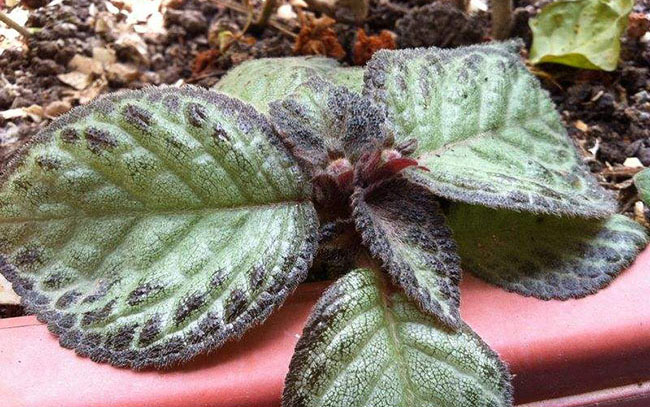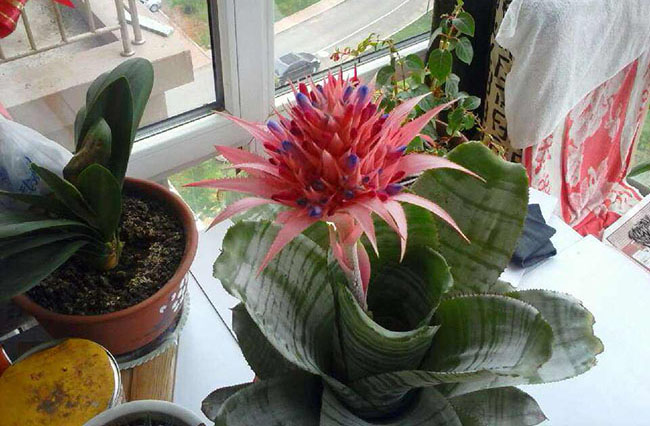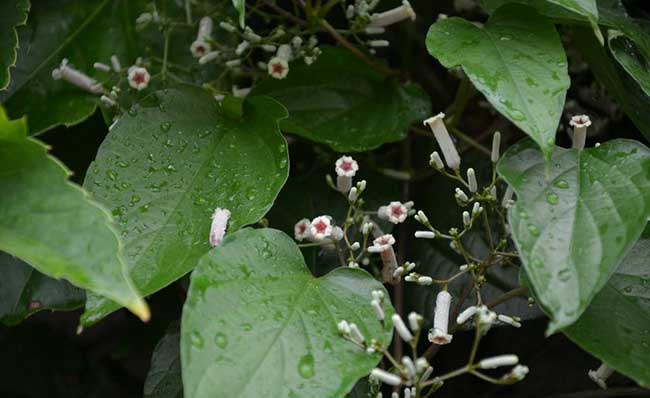Cultivation and propagation of shade-loving flowers
The characteristics of perennial evergreen herbs. The plant of Xiyin flower is short, only ten centimeters high, more creeping and branched. Leaves opposite, oval, dark green or brown, margin serrated, base cordate; foliage wrinkled and densely fluffy, silver-white midrib from base to tip, grayish green on both sides of midvein and tertiary veins, light green or reddish on the back. Stolons grow from the axils of the leaves at the base of the stem and extend outward along the soil, and plantlets grow at the top of the stem. Flowers solitary or in small clusters in leaf axils, bright red, flowering from spring to autumn. Fruiting autumn

The method of propagation of Xiyinhua
Sowing: from April to May, the suitable temperature for germination is 20 °C-24 °C. two weeks after sowing, the seedlings grow faster and the diameter of the next year can reach more than 1cm.
Cuttage: suitable for spring and autumn, cut off the seed ball beside the mother plant, dry the wound and insert it into the sand bed, which can take root after 25 mi for 30 days.
Grafting: from May to June, the rootstock can be used as a rootstock, cactus, and the scion should be a biennial seedling or a seed ball beside the mother plant. It can heal and survive in the next 15 days, and grow rapidly after survival.
Culture method of Xiyin flower
Yin flower propagation can be used to sow seeds, but generally use cuttings and ramet. Ramet is generally planted in late spring and early summer when the plant extending along the stolon is cut off from the rhizome, and the mother plant can be divided into several pots. Cuttings can be carried out from spring to autumn and are easy to take root. Cuttings often use leaf cuttings, that is, leaves are removed with stalks, and petioles are inserted in river sand or vermiculite to keep them moist. It can take root in about half a month.
The potted soil of Xiyin flower should be loose, breathable and well drained. It can be prepared by mixing garden soil, rotten leaf soil and river sand with a small amount of base fertilizer, or it can be planted with moss alone. Change the basin every spring. Dilute liquid fertilizer is applied every half a month in the growing season, pay attention to do not sprinkle fertilizer and water on the leaf surface when applying fertilizer, otherwise it is easy to cause leaf rot. The growth of Xi Yinhua needs dark light, but the sunshine is too strong, the leaves are very easy to die; insufficient or too shady light will affect flowering, so it is necessary to create semi-shady conditions. It likes warmth, the suitable temperature for growth is 20-30 ℃, and the overwintering temperature is 10 ℃. Keep the basin soil moist during the growing season, if too much water causes the plant to rot and die, and keep the basin soil slightly dry in winter to resist the cold and survive the winter.
In addition, the leaf surface of Xiyin flower is hairy, so we should pay attention to avoid leaf injury, so as not to cause rot or infection of anthracnose and brown spot in high humidity; spray 1000 times topiramate or carbendazim for foliar protection if necessary.
The Culture method of Xiyin Flower morphological characteristics of Xiyin Flower
The leaf color of Xiyin flower is beautiful, the flower color is red, and the flower is solitary or in small clusters between leaf axils, flowering from spring to autumn. Then how to raise Xiyin flowers? What are the morphological characteristics? Let's learn about it next.
I. Culture method of Xiyin flower
Yin flower propagation can be used to sow seeds, but generally use cuttings and ramet. Ramet is generally planted in late spring and early summer when the plant extending along the stolon is cut off from the rhizome, and the mother plant can be divided into several pots. Cuttings can be carried out from spring to autumn and are easy to take root. Cuttings often use leaf cuttings, that is, leaves are removed with stalks, and petioles are inserted in river sand or vermiculite to keep them moist. It can take root in about half a month.
The potted soil of Xiyin flower should be loose, breathable and well drained. It can be prepared by mixing garden soil, rotten leaf soil and river sand with a small amount of base fertilizer, or it can be planted with moss alone. Change the basin every spring. Dilute liquid fertilizer is applied every half a month in the growing season, pay attention to do not sprinkle fertilizer and water on the leaf surface when applying fertilizer, otherwise it is easy to cause leaf rot. The growth of Xi Yinhua needs dark light, but the sunshine is too strong, the leaves are very easy to die; insufficient or too shady light will affect flowering, so it is necessary to create semi-shady conditions. It likes warmth, the suitable temperature for growth is 20-30 ℃, and the overwintering temperature is 10 ℃. Keep the basin soil moist during the growing season, if too much water causes the plant to rot and die, and keep the basin soil slightly dry in winter to resist the cold and survive the winter.
In addition, the leaf surface of Xiyin flower is hairy, so we should pay attention to avoid leaf injury, so as not to cause rot or infection of anthracnose and brown spot in high humidity; spray 1000 times topiramate or carbendazim for foliar protection if necessary.
Second, the morphological characteristics of Xiyin flower.
Evergreen plants of Gesneriaceae. The whole plant has dense fine hairs, the plant height is more than 10 cm, the plant is short, the height is only ten centimeters, most of them are creeping and branched. The stem is succulent and soft, densely white tomentose, and the stem internodes are easy to grow stolon seedlings on the ground. The stem grows in the axil of the leaf, creeping, with small plants at the tip and rooting at the base. Leaves opposite ovate-fleshy, base cordate, green or green with bronze; veins silver-white, foliar green wrinkled, middle ribs and tertiary veins reticulate. Leaves away from light green or light red, densely white soft hairs, leaf margin serrulate. Flowers solitary leaf axils or small clusters in leaf axils, small and lovely, petals 5, orange-red or other colors, pedicels slender bright red. Flowers bloom from late spring to summer, flowering from spring to autumn, cultivated for ornamental.
The above are the cultivation methods and morphological characteristics of shade flowers. Friends who like yin flowers may wish to have a look. Yin flowers are often used under the forest and on rockery rocks to protect shade. Potted plants are suitable for balcony, windowsill and desk display.
The Culture method of Xiyin Flower
Yin flowers are often sown and cut. Grafting and reproduction. Next, we introduce the matters needing attention when planting Xiyin flowers:
Sowing: from April to May, the suitable temperature for germination is 20 °C-24 °C. two weeks after sowing, the seedlings grow faster and the diameter of the next year can reach more than 1cm. Cuttage: suitable for spring and autumn, cut off the seed ball beside the mother plant, dry the wound and insert it into the sand bed, which can take root after 25 mi for 30 days.
Grafting: from May to June, the rootstock can be used as a rootstock, cactus, and the scion should be a biennial seedling or a seed ball beside the mother plant. It can heal and survive in the next 15 days, and grow rapidly after survival.
- Prev

Culture methods and matters needing attention of Calyx mandshurica
The pineapple prefers warm, humid, sunny environment. Only under bright light can it blossom normally and obtain the most beautiful leaves, but it is still necessary to prevent direct sunlight at noon in summer. The suitable growth temperature is 20-30 ℃ in summer and 15-18 ℃ in winter.
- Next

Culture methods and matters needing attention of Tripterygium wilfordii
The morphological characteristics of Tripterygium paniculata are herbaceous vines. Branchlets Terete, longitudinally ribbed, often glaucous, glabrous. Tendrils 2-branched, interspersed with leaves at intervals of 2 segments. The leaves of Tripterygium wilfordii are cordate-ovoid, 5-13 cm long and 4-9 cm wide, apex acute or acuminate, base cordate.
Related
- Fuxing push coffee new agricultural production and marketing class: lack of small-scale processing plants
- Jujube rice field leisure farm deep ploughing Yilan for five years to create a space for organic food and play
- Nongyu Farm-A trial of organic papaya for brave women with advanced technology
- Four points for attention in the prevention and control of diseases and insect pests of edible fungi
- How to add nutrient solution to Edible Fungi
- Is there any good way to control edible fungus mites?
- Open Inoculation Technology of Edible Fungi
- Is there any clever way to use fertilizer for edible fungus in winter?
- What agents are used to kill the pathogens of edible fungi in the mushroom shed?
- Rapid drying of Edible Fungi

